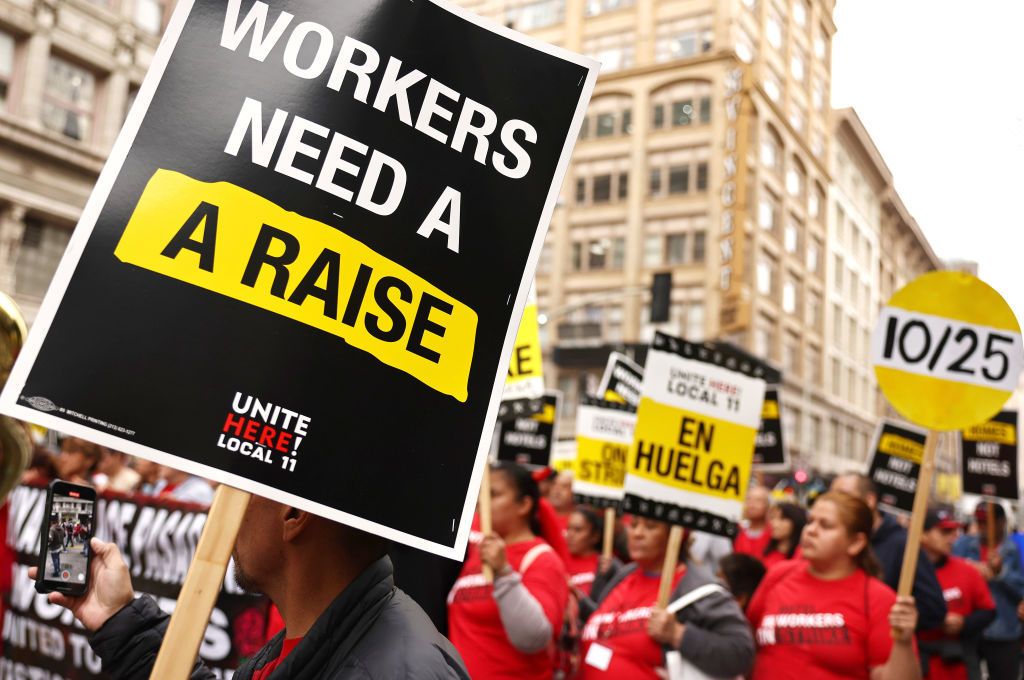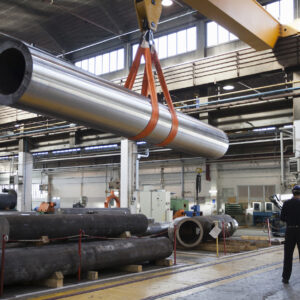Fair Transition Funds, Employer Neutrality, and Card Checks: How Industrial Policy Could Relaunch Labor Unions in the United States
February 12, 2024
By César F. Rosado Marzán
"Union decline thus threatens the US middle class as we have known it—which came into being because of unions. Without a robust middle class, US democracy is also at risk (Sitaraman 2017), as unions directly shape democratic governance."
Introduction
Over the past 70 years, United States union membership has declined steadily to record lows (Tucker 2018). Changes in US industrial composition (Farber and Western 2002) and ossified labor laws that limit labor’s capacity to adapt to new realities (Estlund 2007) have significantly contributed to the decrease in union membership. Union density, or the percentage of wage and salary workers who are members of unions, peaked in the 1950s (Tucker 2018). At that point, about one in three US workers were members of unions and were covered by collective bargaining agreements (Rosenfeld 2014, 1). Today, less than 6 percent of private-sector workers are members of unions or covered by collective bargaining agreements (Hirsch, Macpherson, and Even 2023). Union decline, in turn, has significantly contributed to US income inequality (Western and Rosenfeld 2011; Farber et al. 2021). Union decline thus threatens the US middle class as we have known it—which came into being because of unions. Without a robust middle class, US democracy is also at risk (Sitaraman 2017), as unions directly shape democratic governance (Cornell 2022). Democracy—defined either as popular participation in elections and protest events (Kerrissey and Schofer 2013), or as observed in historical coalitions that strive for political equality (Rueschemeyer, Huber Stephens, and Stephens 1992, 245) or that combat authoritarian regimes (Berins Collier 1999)—is directly linked to robust labor unions (See also Tucker 2018).
Given the importance of unions for democracy and for a strong middle class, this essay describes how US industrial policy can reinvigorate US unions. It focuses on industrial policy rather than on labor law because federal labor law reform has proven an almost impossible task (Estlund 2007). On the other hand, in light of the 2021 Infrastructure Investment and Jobs Act, the 2022 CHIPS1 and Science Act, and the 2022 Inflation Reduction Act (IRA), industrial policy has become a more tangible reality. However, as the US has only had episodic and rare experiences of industrial and labor policies being woven together, this essay begins with lessons we can draw from places where industrial policy has been used effectively to promote both industry and unions. The first example is the Swedish “Rehn-Meidner” model, perhaps the gold standard of how to weave industrial and labor policy. The Rehn-Meidner model’s main goals were to promote full employment while curbing inflation. It did so by imposing wage restraint for highly paid workers, mostly employed in high-productivity and export-based industries (Pontusson 1992, 96). But it is difficult to transplant policy ideas directly from Sweden to the US given the stark differences between the countries. Therefore, this essay also explores examples from Puerto Rico, a US territory with many similarities with the rest of the US, including a collective bargaining scheme structured by the National Labor Relations Act (NLRA). Key elements of the scheme included centralized wage bargaining through wage boards and neutrality and card check recognition voluntarily granted by employers. Neutrality refers to when employers take no public position—neither in favor of nor against—regarding employee choice of joining a union and collective bargaining. Card checks refer to the practice by which employers voluntarily recognize a union when it proves majority employee support through a showing of employee-signed union cards rather than through the more formal process of a government-administered union election.
After discussing the cases of Sweden and Puerto Rico, this essay then reflects on how contemporary US industrial policy could help sustain new worker organizing and reinvigorate unions. Neutrality and card checks can help curb employer opposition to unions. Congress can also help create labor and employer comanaged “Fair Transition Funds” to develop workers’ skills and to match workers to jobs for a new, green economy.
The Gold Standard: Rehn-Meidner
The Rehn-Meidner model of wage solidarity is perhaps one of the best-regarded government programs that used industrial policy to, in part, also give unions leading roles in economic transition. Rehn-Meidner was a comprehensive economic and wage policy program in Sweden (Erixon 2021) that started in 1951 to 1952 and prevailed until 1983, when some of Sweden’s white-collar unions withdrew from the plan (Quintas and Ianoni 2021). It aimed to promote full employment while curbing inflation (Erixon 2021). Overall, it succeeded in meeting its deflationary and employment goals, developing more productive industry in Sweden and giving unions a leading role in shaping and implementing the plan.
Until about the Korean War, Sweden’s main ruling party, Socialdemokraterna (the Social Democratic Party, or SDP), a left-wing party tied to the country’s strong labor unions, promoted full employment through a combination of low interest rates and high government expenditures. However, the Korean War spurred inflation globally, including in Sweden. In response to Swedish policymakers’ concerns about rising inflation, the SDP and the leading labor union in Sweden, Landsorganisationen i Sverige (LO, or the Swedish Federation of Trade Unions), which represented blue-collar workers, put forward a plan aiming to curb inflation by limiting wage growth at the top of the income pyramid (Erixon 2021). But unions were willing to exert wage restraint at the top only if they could promote wage increases at the bottom of pay scales. Employers that could not afford higher wages, likely because of their poor productivity, would be forced out of business (Pontusson 1992, 96). In this manner, Rehn-Meidner expressly sacrificed low-productivity, low-wage employers. It promoted efficiency and tried to improve Sweden’s economic performance by combating inflation and compressing wages (Hibbs and Locking 2000). The policy expressly favored capital concentration in large corporate entities that were “highly competitive internationally” (Quintas and Ianoni 2021). Rehn-Meidner thus picked losers and winners. As described by Felipe Quintas and Marcus Ianoni (2021), two contemporary students of the Rehn-Meidner system: “The [Rehn-Meidner] plan operated an economic policy of artificial selection of companies so that only those that favor accumulation, social welfare and competitiveness in international trade would survive.”
The wage solidarity scheme was intended to impact all workers; the higher the wages of the workers concerned, the less wage growth they would experience. One study looking at wage growth in 1972 through 1982 among blue-collar workers found that workers in the bottom decile of the distribution experienced increases that were three times higher than those at the median of the wage scale. Workers at the median of the wage scale experienced wage growth that was 50 percent higher than that of workers in the top decile (Albrecht, Bjorklund, and Vroman 2011).
Moreover, two different unions not directly privy to Rehn-Meidner, the Tjänstemännens Centralorganisation (Central Organization of Salaried Employees, or TCO) and the Sveriges akademikers centralorganisation (Swedish Confederation of Professional Associations, or SACO), both representing white-collar workers, also negotiated framework agreements that provided for higher wage growth at the bottom of the pay scale (Albrecht, Bjorklund, and Vroman 2011). Therefore, at least for some time, wage solidarity became a significantly institutionalized practice in Sweden.
Because wage growth at the bottom would put many less productive firms out of business, the LO advocated for—and employers agreed to set up—funds to provide unemployment benefits to workers who might lose their jobs, to retrain workers who lost jobs, and to match these workers to new jobs being created in more productive sectors of the economy, especially in export industries (Pontusson 1992, 64-68). These activities constituted so-called “active labor market policies” that are typical in Nordic countries and in some continental European countries (Pontusson 2005, 125-126) classified as “coordinated market economies” (Hall and Soskice 2001, 8).2 Unions played a critical part in managing unemployment, retraining, and job matching schemes; they were crucial for workers in the transition to high productivity.
While difficult to prove causation, it was also true that during the decades Rehn-Meidner was in operation, Swedish union density increased until it reached a peak of 83 percent during around the 1980s (Albrecht, Bjorklund, and Vroman 2011).
The Swedish Rehn-Meidner model came to an end in 1986. One reason for its demise included an inability of the system to keep high-paying employers from exercising wage moderation; these employers wanted to pay workers higher wages to better attract and retain talent and remain internationally competitive. The largest industrial union, LO, felt compelled to bargain agreements outside the scheme with large employers in the “engineering” industry, including Volvo, Saab, and ABB, among others, and with the Swedish Employers’ Confederation (Svenska Arbetsgivareföreningen, or SAF) (Edin and Topel 1997, 160). 3
But despite the end of Rehn-Meidner, there is no question that the legacy of the model was, and continues to be, profound. Swedish unions control significant unemployment funds. National and industrial bargaining schemes strengthened by Rehn-Meidner still prevail, even if not all the time or in every industry (Dimick 2012). Sweden has one of the highest levels of union density in the OECD region, with rates fluctuating between 65 and 80 percent over the past 20 years (OECD 2023a). Despite growing inequality in Sweden during the past two decades, the country remains one of the least unequal countries on earth. Its citizens are part of a robust middle class and enjoy some of the planet’s highest standards of living (see OECD 2023b). Despite contemporary challenges, including the rise of a far-right party (Asbrink 2022), it is a rich and equitable country overall.
But the US is not Sweden, and blindly transplanting Swedish law and policy to the US is likely doomed to fail. Sweden, as stated earlier, is a prime example of a “coordinated market economy” built in great part on bargaining relations between large, organized actors such as national unions and employer organizations. These organized groups coordinate activities to build markets (Hall and Soskice 2001, 8). As one of the starkest models of a “liberal market economy,” the US is its opposite (Hall and Soskice 2001, 10). Liberal market economies prize arm’s-length transactions and market competition. Additionally, in the US, national union and employer groups do not bargain substantially at the national level. Industrial relations are decentralized, and if they exist at all, unions typically bargain at the plant or employer level. While Sweden currently has about 65 percent union density, the US has about 10 percent (OECD 2023a). In the private sector, US union density has all but collapsed, and is at about 6 percent (Hirsch, Macpherson, and Even 2023).
The next part of this essay discusses the case of Puerto Rico, a US territory that, despite being similar to the rest of the US in certain ways, was able to weave industrial and labor policies in the 1950s to 1970s in its garment industry.
Puerto Rico: A Case of Promoting Industry and Unions in the US
At various times and places in US history, unions acted as players with influence over national policy, including over industrial policy, which in turn helped unions retain an institutional role and build organizational capacity. Union participation in the National Defense Mediation Board (NDMB) and its successor, the National War Labor Board (NWLB), are perhaps the clearest examples of US union relevance in national industrial promotion. Historian Nelson Lichtenstein described the importance of these tripartite government agencies for the maintenance of labor peace during wartime in industries involved in the production of arms, equipment, and other materials. Both the American Federation of Labor (AFL) and the Congress of Industrial Organizations (CIO) accepted—after some controversy and false starts—the authority of those bodies and participated in them. Heads of unions were also appointed to them as labor representatives (Lichtenstein 2003, 51).
Like Swedish unions, which conceded to employers by agreeing to restrain wages for workers at the top of the income scale, during World War II US unions agreed to limit wage demands and militancy when they participated in the NMB-NWLB. In return for moderation and labor peace, labor leaders demanded “union security,” or union shops. Union shops are arrangements in which all employees employed by an employer must be automatically enrolled to the union after their hiring. In response to this demand, the NWLB enacted a policy in 1942 called “standard of maintenance-of-membership formula,” in which any newly employed war employee, or war employee covered by a new collective bargaining agreement, had 15 days to declare their intent not to enroll in the union. After those 15 days expired, the employee would be automatically enrolled in the union, had to pay union dues, and had to otherwise follow union rules (Lichtenstein 2003, 79-80). According to Lichtenstein (2003, 51), these union shops “automatically applied to any union whose leaders agreed to enforce the no-strike pledge and otherwise cooperate with the production effort.”4 The policy filled union coffers, and with more money at their disposal, US unions launched organizing efforts in places where they lacked significant presence, including in Texas and Southern California (Lichtenstein 2003, 81).
Some may argue that wartimes are exceptional periods with limited generalizability. But tripartite boards in the US have not been exclusive to wartime. Perhaps one of the most successful US peacetime sectoral experiments in which unions promoted industry while also gaining organizational leverage was in Puerto Rico. There, US unions participated in a wage board scheme that helped them to significantly unionize the garment sector while at the same time contributing to Puerto Rico’s export-led economic strategy in the 1950s through 1970s (Rosado Marzán 2020).
Puerto Rico is not a US state. It is a US territory. As such, the island has been under the plenary powers of the US Congress since the US claimed it as war booty in 1898. Congress granted Puerto Rico some local government powers in 1952. Even if not a state, its local government, ill-termed in English a “Commonwealth,” and in Spanish “Estado Libre Asociado” (Free Associated State) is subject to all federal laws “that are not locally inapplicable.”5 Federal labor and employment laws have thus been binding in Puerto Rico unless otherwise explicitly excluded by the US Congress. This means that Puerto Rico has been subject to US labor and employment laws, including the NLRA.6 However, the Fair Labor Standards Act (FLSA) was one such law that did not always apply to Puerto Rico. Congress excepted it from the FLSA’s provisions until around the 1970s to promote a low-wage policy that could attract US industry to Puerto Rico. As such, in the 1950s to 1970s, the island was a landing pad for US “runaway industry” seeking lower labor costs and taxes (Galvin 1979, 132-133).
Puerto Rico posed a real threat to US union members employed in industries eyeing the island’s low-cost lure. Therefore, once the AFL-CIO formed in 1955, it declared the island a “haven for runaway industry” and began a campaign to curb its low-wage policy (Galvin 1979, 157). It first tried to have Congress extend the FLSA to Puerto Rico. This alarmed Puerto Rican elected leaders and policymakers who were waging bets for Puerto Rico’s economic development based on attracting US light industry through low wages and tax breaks. Puerto Rico lacks political power in Washington, DC—it has no voting members in Congress nor can it vote for the US President7—and so the AFL-CIO, with many allies in DC, was a formidable foe (Rosado Marzán 2020). However, Congress was not too eager to extend the FLSA to Puerto Rico. The territory served valuable strategic and symbolic goals during the Cold War: It was showcased as an alternative to anti-colonial and communist insurgency, and the US federal government gave Puerto Rico special treatment to enhance its showcase potential (Grosfoguel 2003).
Once extending the FLSA became difficult, the AFL-CIO switched gears and started to engage with the government of Puerto Rico to see how it could promote unionization in the island’s nascent industry. The government of Puerto Rico was willing to engage if US unions stopped insisting on their plans for FLSA extension. Considering that pact, the government of Puerto Rico supported AFL-CIO unions, including the International Ladies and Garment Workers Union (ILGWU), having a seat on the wage committees of its Minimum Wage Board, a tripartite board with authority to set minimum wages in Puerto Rican industry. Under federal and Puerto Rico law, the Board acted as a substitute of Washington, DC’s FLSA. The ILGWU learned how to use the Board to set minimum wages in all garment shops in Puerto Rico. Given the reality of low wages in Puerto Rico, the Board’s minimum wages became the prevailing wages for workers in the garment industry—indeed, in all manufacturing (Galvin 1979, 134).
But the ILGWU did not stop at the Board. It persuaded employers to grant neutrality and card check agreements and, if a majority of the workers requested union representation, to extend all noneconomic terms in their US mainland collective bargaining agreements to those contracts bargained on the island. One reason employers were willing to make these concessions to the ILGWU was that wages had been dealt with by the Board. But a second reason was that the garment plants were mostly US-based and dealt with the ILGWU on the mainland. In essence, the union was seeking the same terms it bargained for with employers in the US, excluding economic terms bargained through the Board and marginally at the plant level. Finally, the ILGWU was successful in negotiating for slightly better wages at the plant level than those mandated by the Board (Galvin 1979, 151). It was also adept in negotiating fringe benefits for their members (Galvin 1979, 151).
The result of the ILGWU’s scheme was a compromise that, among other impacts, kept the garment industry growing into the 1970s and increased union membership until it reached about 30 percent of the garment workforce. Despite being almost completely disorganized in the late 1950s, in the 1970s the union reported 13,000 members (Rosado Marzán 2020).
While Puerto Rico did not create a generally encompassing bargaining scheme accompanied by training, job matching, and benefits funds for all workers, such as in Sweden, industrial policy set wages centrally through the Board. Not only did unions find a foothold there but they also created an institutional role for themselves by further moderating wage demands to bargain for benefits through single employer or workplace-based collective bargaining. Employers were willing to extend neutrality and card checks since wages were dealt at the Board level, and the ILGWU had preexisting relationships with the same employers in the United States. As a result, the union grew. We now turn to the question: Can something like that be replicated in the United States today via industrial policy?
Promoting Unions with Industrial Policy in the United States Today
The US federal government is spending significantly to promote specific industries, including green industry (Bivens 2023). Some important beneficiaries of federal programs include Tesla, the wind turbine industry, the electric automaker Rivian, electric bus automaker Lion Electric, and battery makers supplying the “Big 3” unionized automakers (Gallucci 2023; Jin 2023; Harris 2022). All of these green firms are nonunion, as are most firms in the US today. As described above, an important reason union membership has declined in the US is that historically unionized industries have been declining in relative importance, giving way to industries that are nonunion. A shift to green industry will thus further erode union membership in the US unless unions can make inroads in these new industries.
As demonstrated by the Swedish and Puerto Rican examples, government-orchestrated industrialization can help unions grow. Organized labor and the Biden administration know this. For example, the Service Employees International Union’s (SEIU’s) chief economist and policy director, Janelle Jones, has argued that industrial policy could bolster industries and unions in the service economy, in which many women and people of color—historically policy afterthoughts and at the margins of labor protective legislation and union representation—work (Tucker et al. 2023).
Indeed, the IRA includes some pro-labor conditions, such as incentives to promote union apprenticeship programs and mandating prevailing wages (US Department of Treasury 2023). Some parts of “Bidenomics” place conditions on firms so that they do not use government money to oppose unions. Indeed, some companies that receive direct federal subsidies are required to remain neutral during a union election and/or voluntarily recognize a union (Weisman 2023). These are positive steps, but they remain insufficient to build a significant new union presence in new industry (See Harris 2022). Currently, and for several decades now, US federal labor law lets employers mount anti-union campaigns that have proven highly effective in thwarting unionization (Weiler 1983). Thus, a more robust policy would include mandating employer neutrality and card checks in all green firms profiting from federal subsidies, tax breaks, grants, and other benefits. Neutrality and card checks were central in the Puerto Rican experience. They seem equally necessary today in the US. While there were discussions of including such broad conditions on firms benefiting from the IRA and CHIPS, they never made it past the political tug of war that legislation normally involves (Harris 2022).
The federal government could also help promote what this essay calls “Fair Transition Funds,” which can help unions lead in the transition to a green and fair economy. These funds, like Taft Hartley funds, would be comanaged by labor and management representatives. Green, profitable firms benefiting from industrial policy—e.g., the Teslas, Rivians, and the Lion Electrics of the US—should play a principal role in funding them. The funds could institute supplementary unemployment benefits,8 retraining, and job matching programs—active labor market plans—to help move workers from non-green to green jobs, and thus better guarantee them as being “winners” of the green transition. US workers would be more apt to perceive union membership as important if unions can provide transition benefits to their members. Fair Transition Funds would thus provide a visible and influential institutional role for unions to lead in the green transition.
Different from the bargains in both Sweden and Puerto Rico, in which wage moderation was key for unions to receive the benefits of industrial policy, the deal today in the US would be between promoted green industry—e.g., solar and wind industries, electric car manufacturers, etc.—and the US government.9 Industries would be federally supported if they can better guarantee quality union jobs for those who will lose in the transition, such as workers in the fossil fuel industry, and for new worker entrants into green industry.
The public would benefit from Fair Transition Funds, employer neutrality, and card checks because of the important supports unions provide to the US middle class and to American democracy—all public goods. A green economy devoid of a middle class and threatened by oligarchy and autocratic government is not the bright future we hope for.
However, time is running out for the federal government to enact such changes. Once green industry takes off, becoming self-sufficient and profitable—which should be the goal—government incentives will be less attractive to green industry. And once government incentives are no longer attractive, using those incentives to promote unions would no longer be viable. Unions would have to sustain themselves in a different industrial context, in which they might be even less relevant than today.
Addressing Some Skeptics
The ideas outlined here—neutrality, card checks, and Fair Transition Funds—may raise questions.
First, the Biden administration already tried to include neutrality and card checks in its prior industrial policies, with limited success. Can it, or a successor administration, succeed despite past failures? It is hard to answer this question, but given the current structure of US labor law, union organizing rules, and collective bargaining, neutrality and card checks are necessary to significantly promote union membership growth. Absent labor law overhaul, the federal government must better guarantee neutrality and card checks, and it could do so through a spending bill.
Second, some may question the constitutionality of mandated neutrality and card check recognition. Wouldn’t the federal government be infringing on the first amendment rights of employers if it places conditions on their speech? This is a complex constitutional question with an answer beyond the space limits of this short piece. But the brief answer is that there should be no constitutional bar to a federal spending bill that includes neutrality and card check conditions for employers who voluntarily accept those benefits. The US Supreme Court has long established the right of the federal government to use the power of its purse to pursue policy objectives even if these objectives result in favoring some points of views over others.10 The government may also provide tax benefits based on different viewpoints without violating the first or fifth amendments.11 Moreover, neutrality and card checks would not force any employer to voice any particular view on unions. These mechanisms simply require employers to remain neutral—to essentially refrain from voicing their opinion—during the power-sensitive process of a union election in which employer speech is recognized by workers to be more than just an expressive act.
Third, which unions and employers would be part of the Fair Transition Funds? How will the federal government compel these parties to participate in them? How will the funds be underwritten? How would workers qualify to participate in them? Which schools or institutes will retrain and job match the workers? Hasn’t the US federal government and many state and local governments already toyed with retraining programs, with varied measures of success? Shouldn’t we first learn from those experiences before attempting to create new training programs?
These are certainly essential questions that we must answer to craft a viable policy for Fair Transition Funds. But before we discuss those details, we should agree, in principle, that unions and employers should collaborate in a body that sets up these funds to help workers transition to a green and fair economy. Once we reach that threshold agreement, we can discuss the details.
Conclusion
US workers have not been equal recipients of US economic vitality and its bounty. Over the past 50 years, they have seen their economic conditions deteriorate, while individuals at the top income levels have seen their fortunes expand exponentially.
Union decline has been a major reason for the worsening conditions of worker incomes and a direct contributor to economic inequality. Changes in industrial composition have contributed to union decline. The shift to a green economy shepherded by US industrial policy could give labor an opportunity to gain some lost ground, but only if US industrial policy includes express provisions that help unions grow.
Other countries, such as Sweden, have been able to build unions through industrial policy experiments. Puerto Rico, a small US territory, was also able to do so for its garment sector. The key ingredients in Sweden were centralized collective bargaining and robust institutional roles for unions to help lead the transition to high productivity. In Puerto Rico, centralized bargaining came through wage boards and institutional roles for unions to bargain for employee benefits at the plant level. Employer neutrality and card checks were also important to build union membership at the plant level. In the US today, Fair Transition Funds could promote some form of centralized authority for unions. These funds can smooth workers’ shift to green jobs through training, job placement, and unemployment benefits for those who are between jobs. Workers would find that unions can be relevant in making them winners in the new green economy. Unions, in turn, will be better able to seize on the opportunity afforded to them by workers’ improved perception and desirability for unions with the tools provided by employer neutrality and card checks. The federal government should act quickly while it still has an opportunity to help support unions as we move toward a green transition.
____
The author thanks Robin Clark-Bennett, Deepa Das Acevedo, Matthew Dimick, Catherine Fisk, Andrew Jordan, Amy Koopman, Sunny Malhotra, Madison Rush, Todd Tucker, the participants of the 2022 Colloquium on Scholarship in Employment and Labor Law, and participants of the 2022 Roosevelt Institute Industrial Policy Convening. The author would also like to thank Claire Greilich and Sonya Gurwitt for their contributions to this project.
Footnotes
Read the footnotes
1“CHIPS” stands for “Creating Helpful Incentives to Produce Semiconductors.” Pub. Law No. 117–167, §102 (2022).
2Coordinated market economies are those in which firms are said to make decisions and take actions based on “insider information” gained through relationships between firms and their stakeholders (Hall and Soskice 2001, 8). Denmark, Germany, Japan, the Netherlands, Norway, and Sweden are said to be coordinated market economies (Hall and Soskice 2001, 20). Liberal market economies are those in which firms principally make decisions and take actions based on market information, such as prices, interest rates, and unemployment levels, and relate to other actors through formal contracting (Hall and Soskice 2001, 10). Political scientists Hall and Soskice (2001, 20, 30) have classified the United States, the United Kingdom, Australia, New Zealand, and Canada as liberal market economies.
3According to some scholars, the Bretton Woods international monetary rules provided the background and global norms that helped to finance Rehn-Meidner. The end of Bretton Woods in 1971 contributed to the demise of Rehn-Meidner (Quintas and Ianoni 2021; Erixon 2010, 684). Bretton Woods attempted to create an international monetary system that was “rules-based and not manipulable by powerful states for mercantilist advantage” (Gowan 1999, 16). It pegged the US dollar, the strongest currency, to the price of gold. All other currencies had to set their value to the dollar, and governments could not unilaterally change their currencies’ prices. The goal was to provide price stability to currencies and promote fair trade. Additionally, Bretton Woods placed strict controls on international capital flows. It permitted financing for trade and for foreign production investment, but “repressed” most other types of international capital movements. These controls gave national state governments institutional heft to subsume their financial sectors to their national development goals, as Sweden could do during the period of Rehn-Meidner (Gowan 1999, 17). Indeed, Rehn-Meidner was made possible by strict capital controls placed on finance. As Quintas and Ianoni (2021) recount, “Swedish capital [was] basically dependent on production, not speculation.” Its central bank was subordinate to the government, and not to capital markets. When capital markets were liberalized globally, a result of the collapse of Bretton Woods, Sweden, like other countries, also had to liberalize its capital markets. That liberalization introduced financial problems to the Rehn-Meidner scheme (Quintas and Ianoni 2021).
4As discussed by Professor Kenneth Dau Schmidt (1990), the Taft-Hartley Act banned the closed shop, which requires pre-employment union membership. In 1963, the US Supreme Court also effectively outlawed the union shop. As Dau Schmidt described it, “In the Taft-Hartley Act, Congress outlawed the closed shop . . . The Supreme Court has also interpreted the second proviso of section 8(a)(3) to prohibit enforcement or observance of the membership requirement of a union shop agreement” (NLRB v. General Motors Corp., 373 U.S. 734 (1963)).
5As the US Federal Relations Act with Puerto Rico states, “[t]he statutory laws of the United States not locally inapplicable . . . shall have the same force and effect in Puerto Rico as in the United States” (48 U.S.C. § 734 [2012]). The meaning of “locally inapplicable” has been the subject of intense litigation and remains an open question (Harvard Law Review 2017).
6See NLRB v. Gonzalez Padín Co., 161 F.2d 353, 355 (1947) (the NLRA applies to Puerto Rico).
7Residents of Puerto Rico can participate in party primaries, however. They can thus influence the choice of party candidates for the US presidency.
8Supplementary unemployment benefits should help sustain workers and their families during workers’ retraining and job matching periods. These funds would go beyond typical unemployment benefits to better guarantee that workers and their families are able to maintain dignified lives during the transition to a green economy.
9Inflation has been one of the hallmarks of “Bidenomics.” Hence, sectoral wage boards such as those prevailing in Puerto Rico could also be used as anti-inflationary tools, like in Sweden, if inflation experts determine that high wages are a leading cause of inflation in the US.
10Rust v. Sullivan, 500 U.S. 173, 193 (1991).
11Regan v. Taxation With Representation of Washington, 461 U.S. 540, 549–550 (1983).
References
Read the references
Albrecht, James, Anders Björklund, and Susan Vroman. 2011. “Unionization and the Evolution of the Wage Distribution in Sweden.” Industrial & Labor Relations Review 64, no. 5 (October): 1039–57. https://journals.sagepub.com/doi/10.1177/001979391106400510.
Asbrink, Elisabeth. 2022. “Sweden Is Becoming Unbearable.” New York Times, September 20, 2022. https://www.nytimes.com/2022/09/20/opinion/sweden-democrats-elections.html.
Bivens, Josh. 2023. “The Inflation Reduction Act Finally Gave the US A Real Climate Change Policy.” Working Economics (blog). Economic Policy Institute. August 14, 2023. https://www.epi.org/blog/the-inflation-reduction-act-finally-gave-the-u-s-a-real-climate-change-policy/.
Berins Collier, Ruth. 1999. Paths toward Democracy: The Working Class and Elites in Western Europe and South America. Cambridge, UK: Cambridge University Press.
Cornell, Angela B. 2022. “Labor’s Obstacles and Democracy’s Demise.” In The Cambridge Handbook of Labor and Democracy, edited by Angela B. Cornell and Mark Barenberg. Cambridge, UK: Cambridge University Press.
Dau-Schmidt, Kenneth G. 1990. “Union Security Agreements Under the National Labor Relations Act: The Statute, the Constitution, and the Court’s Opinion in Beck.” Harv. J. on Legis 27. https://www.repository.law.indiana.edu/cgi/viewcontent.cgi?referer=&httpsredir=1&article=1743&context=facpub.
Dimick, Matthew. 2012. “Labor Law, New Governance, and the Ghent System.” North Carolina Law Review 86: 1619-84. https://digitalcommons.law.buffalo.edu/journal_articles/83/.
Edin, Per-Anders and Robert Topel. 1997. “Wage Policy and Restructuring: The Swedish Labor Market since 1960.” In The Welfare State in Transition: Reforming the Swedish Model, edited by Richard B. Freeman, Robert Topel, and Birgitta Swedenborg. Chicago: University of Chicago Press.
Erixon, Lennart. 2021. “The Stockholm School in a New Age – Erik Lundberg’s Changing Views of the Rehn-Meidner Model.” The European Journal of the History of Economic Thought 28, no. 3 (September): 375-403. https://www.tandfonline.com/doi/full/10.1080/09672567.2020.1819361.
______ 2010. “The Rehn-Meidner Model in Sweden: Its Rise, Challenges and Survival.” Journal of Economic Issues 44, no. 3 (September): 677–715. https://www.jstor.org/stable/20778709.
Estlund, Cynthia. 2007. “The Ossification of American Labor Law and the Decline of Self-Governance in the Workplace.” Journal of Labor Research 28 (July): 591-608. https://link.springer.com/article/10.1007/s12122-007-9012-3.
Farber, Henry S., Daniel Herbst, Ilyana Kuziemko, and Suresh Naidu. 2021. “Unions and Inequality Over the Twentieth Century: New Evidence from Survey Data.” Working Paper no. 24587. NBER Working Paper Series. Cambridge, MA: National Bureau of Economic Research. http://www.nber.org/papers/w24587.
Farber, Henry S., and Bruce Western. 2002. “Accounting for the Decline of Unions in the Private Sector, 1973-1998.” In The Future of Private Sector Unionism in the United States, edited by James T. Bennett and Bruce E. Kaufman. Armonk, NY: ME Sharpe.
Gallucci, Maria. 2023. “US Wind Manufacturing Makes a Comeback Thanks to Inflation Reduction Act.” Canary Media, June 5, 2023. https://www.canarymedia.com/articles/clean-energy-manufacturing/us-wind-manufacturing-makes-a-comeback-thanks-to-inflation-reduction-act.
Galvin, Miles. 1979. The Organized Labor Movement In Puerto Rico. Rutherford, NJ: Fairleigh Dickinson University Press.
Gowan, Peter. 1999. The Global Gamble: Washington’s Faustian Bid for World Dominance. London: Verso.
Grosfoguel, Ramón. 2003. Colonial Subjects Puerto Ricans in a Global Perspective. Berkeley, CA: University of California Press.
Hall, Peter A., and David Soskice. 2001. “An Introduction to Varieties of Capitalism.” In Varieties of Capitalism: The Institutional Foundations of Comparative Advantage. Oxford, UK: Oxford University Press.
Harris, Lee. 2022. “Industrial Policy Without Industrial Unions.” The American Prospect, September 28, 2022. https://prospect.org/api/content/aff4b44e-3e71-11ed-9b46-12274efc5439/.
Harvard Law Review. 2017. “Developments in the Law: The International Place of Puerto Rico.” Harvard Law Review 130, no. 6 (April): 1656-1679. https://harvardlawreview.org/print/vol-130/the-international-place-of-puerto-rico/.
Hibbs Jr., Douglas A., and Håkan Locking. 2000. “Wage Dispersion and Productive Efficiency: Evidence for Sweden.” Journal of Labor Economics 18, no. 4 (October): 755–782. https://www.jstor.org/stable/10.1086/209976.
Hirsch, Barry T., David Macpherson, and William E. Even. 2023. “Union Membership, Coverage, and Earnings from the CPS.” Unionstats.com. Last updated March 22, 2023. https://unionstats.com/.
Jin, Hyunjoo. 2023. “Analysis: Tesla Taps Biden Tax Credits to Offset EV Price Cuts.” Reuters, July 21, 2023. https://www.reuters.com/business/autos-transportation/tesla-taps-biden-tax-credits-offset-ev-price-cuts-2023-07-21#:~:text=The%20battery%20tax%20credits%20in,Tesla’s%20forecast%20and%20U.S.%20sales.
Kerrissey, Jasmine and Evan Schofer. 2013. “Union Membership and Political Participation in the United States.” Social Forces 91, no. 3 (March): 895-928. https://www.jstor.org/stable/23361125.
Quintas, Felipe Maruf, and Marcus Ianoni. 2021. “The Rehn-Meidner Plan and the Swedish Development Model in the Golden Years.” Brazilian Journal of Political Economy 41, no. 1 (January-March): 3–22. https://www.researchgate.net/publication/349696024_The_Rehn-Meidner_Plan_and_the_Swedish_development_model_in_the_Golden_Years.
Lichtenstein, Nelson. 2003. Labor’s War at Home: the CIO in World War II. Philadelphia, PA: Temple University Press.
OECD. 2023a. “Trade Union Dataset.” OECD.stat. Accessed November 5, 2023. https://stats.oecd.org/Index.aspx?DataSetCode=TUD.
______ 2023b. “Income inequality.” OECD Data. Accessed November 5, 2023. https://data.oecd.org/inequality/income-inequality.htm.
Pontusson, Jonas. 1992. The Limits of Social Democracy: Investment Politics In Sweden. Ithaca, NY: Cornell University Press.
______ 2005. Inequality and Prosperity : Social Europe vs. Liberal America. Ithaca, NY: Cornell University Press.
Rosado Marzán, César F. 2020. “Can Wage Boards Revive US Labor?: Marshaling Evidence From Puerto Rico.” Chicago-Kent Law Review 95, no. 1: 127-156. https://scholarship.kentlaw.iit.edu/cklawreview/vol95/iss1/41/.
Rueschemeyer, Dietrich, Evelyne Huber Stephens, and John D. Stephens. 1992. Capitalist Development and Democracy. Chicago: University of Chicago Press.
Rosenfeld, Jake. 2014. What Unions No Longer Do. Cambridge, MA: Harvard University Press.
Sitaraman, Ganesh. 2017. The Crisis of the Middle-Class Constitution: Why Economic Inequality Threatens Our Republic. New York: Knopf.
Tucker, Todd N. 2018. Seven Strategies to Rebuild Worker Power for the 21st Century Global Economy: A Comparative and Historical Framework for Policy Action. New York: Roosevelt Institute. http://rooseveltinstitute.org/seven-strategies-rebuild-worker-power/.
Tucker, Todd N., Sameera Fazili, Jane Flegal, Jennifer Harris, Janelle Jones, K. Sabeel Rahman, and Tim Wu. 2023. Industrial Policy Synergies: Reflections from Biden Administration Alumni. New York: Roosevelt Institute. https://rooseveltinstitute.org/publications/industrial-policy-synergies-reflections-from-biden-administration-alumni/.
US Department of the Treasury. 2023. “US Department of the Treasury, IRS Release Guidance on Inflation Reduction Act Provision to Ensure Good-Paying Clean Energy Jobs, Expand Clean Energy Workforce.” Press release, August 29, 2023. https://home.treasury.gov/news/press-releases/jy1708.
Weiler, Paul. 1983. “Promises to Keep: Securing Workers’ Rights to Self-Organization under the NLRA.” Harvard Law Review 96, no. 8 (June): 1769-1827. https://www.jstor.org/stable/1340809.
Weisman, Jonathan. 2023. “Flush With Federal Money, Strings Attached, a Deep South Factory Votes to Unionize.” New York Times, May 12, 2023, sec. US. https://www.nytimes.com/2023/05/12/us/politics/clean-energy-unions.html.
Explore the Series
The Role of State Ownership: Overview of State-Owned Entities in the Global Economy
by Kyunghoon Kim

Finance as a Tool of Industrial Policy: A Taxonomy of Institutional Options
by Saule T. Omarova
Leading With Industrial Policy: Lessons for Decarbonization from Swedish Green Steel
by Jonas Algers

Just Energy Transition in the Time of Place-Based Industrial Policy: Patch or Pathway to the Green Industrial Transformation?
by Andrea Furnaro
Electric Vehicles: How Corporate Guardrails Can Improve Industrial Policy Outcomes
by Lenore Palladino




